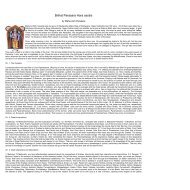Yantra Yantra Should Be Frequently Energized With The
Yantra Yantra Should Be Frequently Energized With The
Yantra Yantra Should Be Frequently Energized With The
Create successful ePaper yourself
Turn your PDF publications into a flip-book with our unique Google optimized e-Paper software.
symmetrical. Let your<br />
thighs, knees and toes<br />
turn outward. Close your<br />
eyes and breathe<br />
deeply.<br />
KAPALBHATI<br />
Kapalabhati is one of the six Kriyas or purification<br />
practices besides being a pranayama. <strong>The</strong> forced<br />
exhalation rids the lower lungs of stale air, making<br />
way for a fresh intake of oxygen-rich air and<br />
cleansing the entire respiratory system. This is a<br />
wonderfully invigorating exercise to begin your<br />
pranayama. Translated literally its name means<br />
"skull shining" exercise and indeed, by increasing<br />
the amount of oxygen in the body, its effect is to<br />
clear the mind and improve the concentration. It<br />
consists of a series of exhalation and inhalations,<br />
followed by a retention of breath. To exhale, you<br />
contract the abdominal muscles sharply, raising the<br />
diaphragm and forcing air out of the lungs; to<br />
inhale, you relax the muscles, allowing the lungs<br />
to fill with air. <strong>The</strong> exhalation should be brief,<br />
active and audible, the inhalation longer, passive<br />
and silent. <strong>The</strong> repeated up and down movement of<br />
the diaphragm tomes the stomach, heart and liver.<br />
<strong>Be</strong>gin by practicing three rounds of twenty<br />
pumping each and gradually work up to rounds of<br />
sixty.<br />
ANULOMA VILOMA<br />
In this alternate nostril breathing exercise,<br />
you inhale through one nostril, retain the<br />
breath, then exhale through the other nostril<br />
in a ratio of 2:8:4. <strong>The</strong> left nostril is the path<br />
of the nadi called Ida, the right nostril that<br />
of Pingala. If you are really healthy, you<br />
will breathe predominantly through the Ida<br />
nostril about one hour and fifty minutes,<br />
then through the Pingala nostril. But in<br />
many people this natural rhythm is<br />
disturbed. Anuloma Viloma restores and<br />
equal flow, balancing the flow of prana in<br />
the body. One round of Anuloma Viloma is<br />
made up of six steps, as shown below. Start<br />
by practicing three rounds and build up<br />
slowly to twenty rounds, extending the court<br />
within the given ratio.<br />
<strong>The</strong> Vishnu Mudra<br />
In Anuloma Viloma, you adopt the Vishnu<br />
Mudra with your right hand to close your<br />
nostrils. Tuck your index and middle fingers<br />
in to your nose. Place the thumb by your<br />
right nostril and your ring and little fingers




